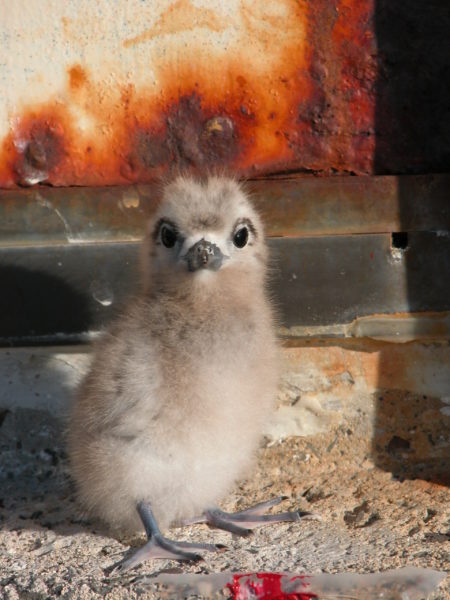Published in the Ocean Watch column, Honolulu Star-Advertiser © Susan Scott
September 24, 2016
If you love the white terns that flit around our trees and add joy to our city, join the club. Really. There is a club.
After my recent white tern column, I learned that several like-minded Oahu residents, researchers and conservation group members, both public and private, have formed a white tern fellowship called Hui Manu-o-Ku. The hui’s purpose is to make sure that this Tinker Bell of seabirds — Honolulu’s official bird — is protected, counted (in both numbers and importance) and continues to thrive.
 A white tern chick lives on a concrete ledge on Tern Island, a tiny coral island
A white tern chick lives on a concrete ledge on Tern Island, a tiny coral island
in the French Frigate Shoals in the Northwestern Hawaiian Islands.
©2016 Susan Scott
No one knows why white terns have chosen urban Oahu to raise their kids, but our tall trees may be a factor. Because white terns lay their eggs and raise their chicks in the crooks of tree branches, tree trimming, a necessity in all cities, is a vital issue for the birds. The hui’s website has tree trimming tips for arborists and homeowners as well as a map of known “nests,” meaning an egg or chick on a branch. A Citizen Science tab explains how you can help record the city’s growing population, what to do if you find a fallen chick and how to volunteer for other activities.
Tree trimming also has a plus side for the terns. Cut branches form cups, forks and scars that can secure eggs, something that may attract the birds to Honolulu.
White terns can breed year-round but their peak egg-laying time is February through June. The female lays one egg. If it falls, she soon lays another, and another if necessary. The parents take turns sitting on the egg for about five weeks. As soon as the hatchling is fluffy and standing on its big clawed feet — useful for hanging onto a bare branch – the parents are off fishing for juvenile goatfish, flying fish and others.
A parent can hold up to eight fish (I have a photo of this amazing feat) crosswise in its small beak, feeding each one whole to its chick. About seven weeks later, the youngster can fly but, like most kids, sticks around home for the next two months for free meals.
Honolulu is the only city in the world that has white terns raising chicks in bustling built-up areas. To learn how to help keep our feathered friends safe and their population growing, or just to see some fabulous photos, check out Hui Manu-O-Ku’s excellent website, whiteterns.org.
And speaking of safe, our Kaena Point albatrosses will be returning there soon, but the vandals who last winter stole equipment, broke eggs and killed nesting parents have not yet been prosecuted.
You can help our albatrosses by asking the city prosecutor when legal action will begin. Send an email using the form at honoluluprosecutor.org/contact-us/ or call 768-7400.